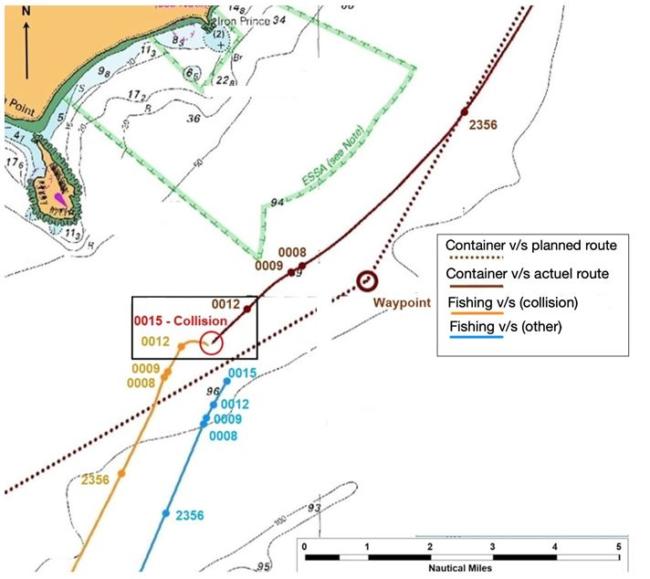202218 Too little to early and too much too late leads to collision
As edited from the ATSB (Australia) report 339-MO-2018-002
Underway in darkness, the OOW on a medium sized fishing boat sighted the masthead lights and green sidelight of an approaching containership fine on the starboard bow. The ship was also detected on radar but was not acquired for tracking at that time.
Meanwhile on the container ship, the OOW visually sighted and later acquired on radar two approaching vessels on the starboard bow, one of which was the fishing vessel. The vessels were about 10nm from the container vessel. The OOW continued to monitor the two vessels, both visually and by radar, while making small adjustments to the heading to maintain the ship on the planned track.
At about 2356, and over the next 10 minutes, the OOW made a succession of small heading alterations that took the ship to starboard in a 'corner cutting' manoeuvre. The next planned course alteration would be to starboard and there was no danger in leaving the current course line.
Meanwhile, the watch had changed on the fishing vessel. The new OOW quickly acquired the container vessel on the radar. The ship was now about 6.5nm away on a south-westerly course with a speed of about 17.5 knots. When the container vessel was now about 4nm away, the fishing vessel's OOW walked the short distance to the trawler’s bow to better assess the situation. He sighted the oncoming container vessel fine on the starboard bow with the ship’s two masthead lights nearly in a line. He returned to the wheelhouse and continued to monitor the approaching ship visually and by radar while maintaining his vessel's course and speed.
By now, the container vessel was steady on the new course with a heading of 241 degrees with the fishing vessel fine on the ship’s port bow. About a minute later, the OOW altered the ship’s heading to port with the intention of passing between the two trawlers and increasing the CPA with the fishing vessel under review. Shortly after, the fishing vessel’s OOW commenced a rapid turn to starboard at a distance of about 1nm from the container ship. In response, the container vessel’s OOW altered the ship’s heading to port by three degrees and flashed the ship’s Aldis lamp followed by a long blast on the ship’s whistle. The OOW then quickly changed the steering over from autopilot to hand steering and placed the wheel hard to port.
Notwithstanding all of these last minute manoeuvres, the two vessels collided with the trawler’s port bow impacting the container vessel's’s starboard side. As the trawler then scraped down the container vessel’s side, the skipper stopped the engine and the crew mustered in the wheelhouse. The trawler heeled over sharply to starboard and took on some water before it righted itself, passed the ship’s stern and drifted away to the north-east.

Lessons learned
- Early and substantial action is the key to avoiding dangerous situations as above.
- Early and substantial action is not limited to course alterations. Both OOWs were concerned about the developing situation and each chose course alterations as the unique and sole solution. But, because some of these actions were not substantial enough or others too late, they actually contributed to the collision. Had either vessel slowed, the developing situation would have resolved itself.
- When in doubt, slow down.
